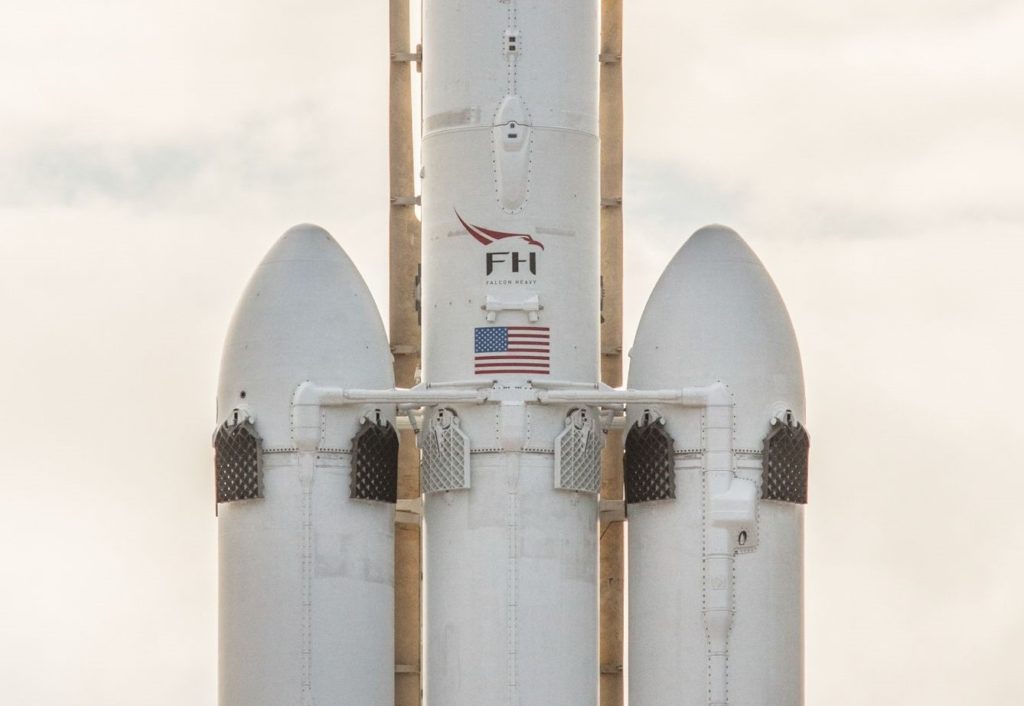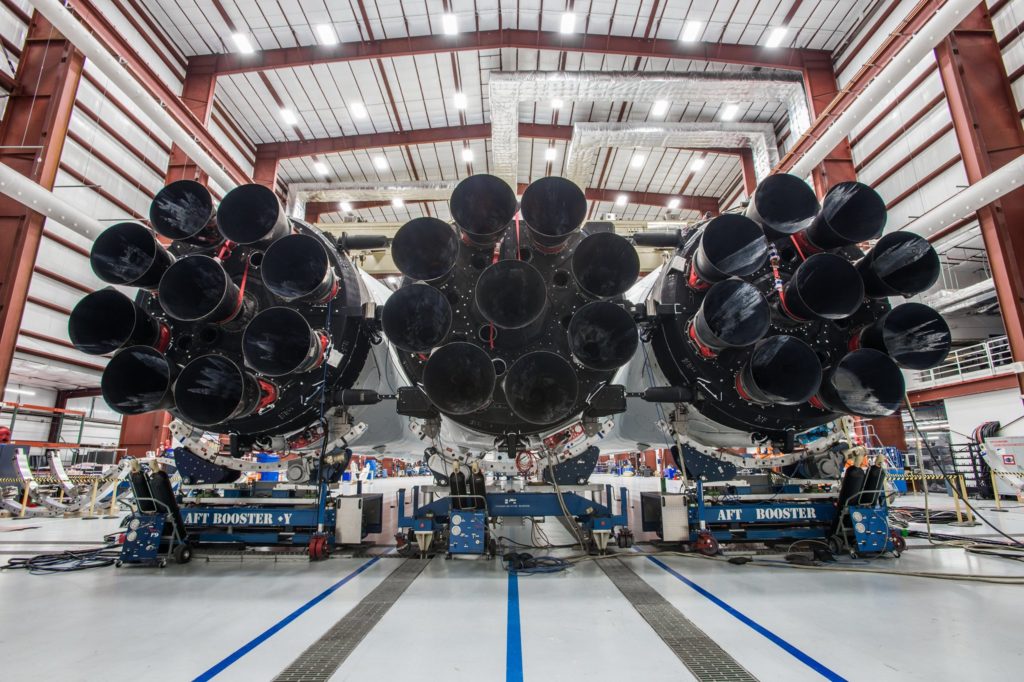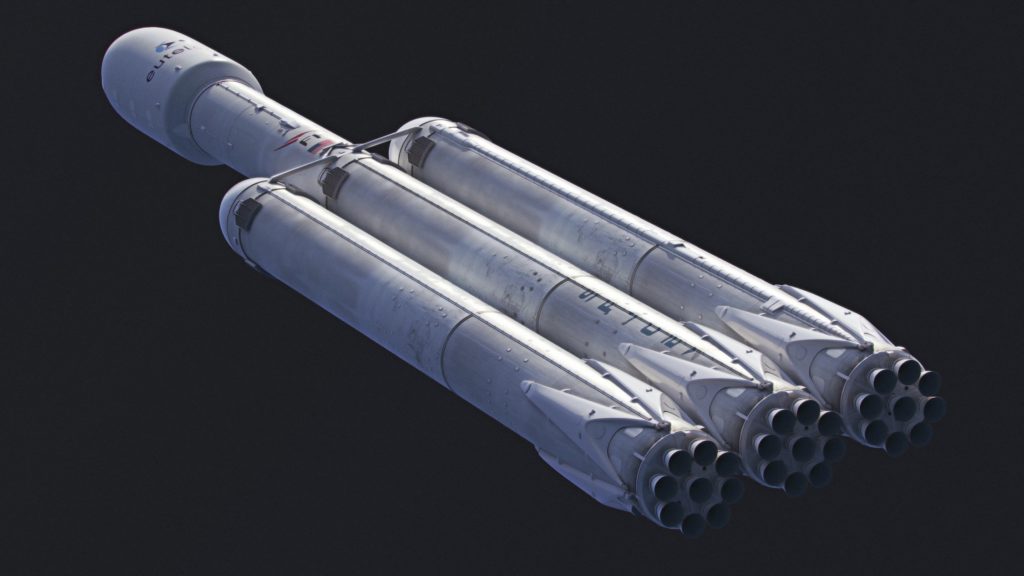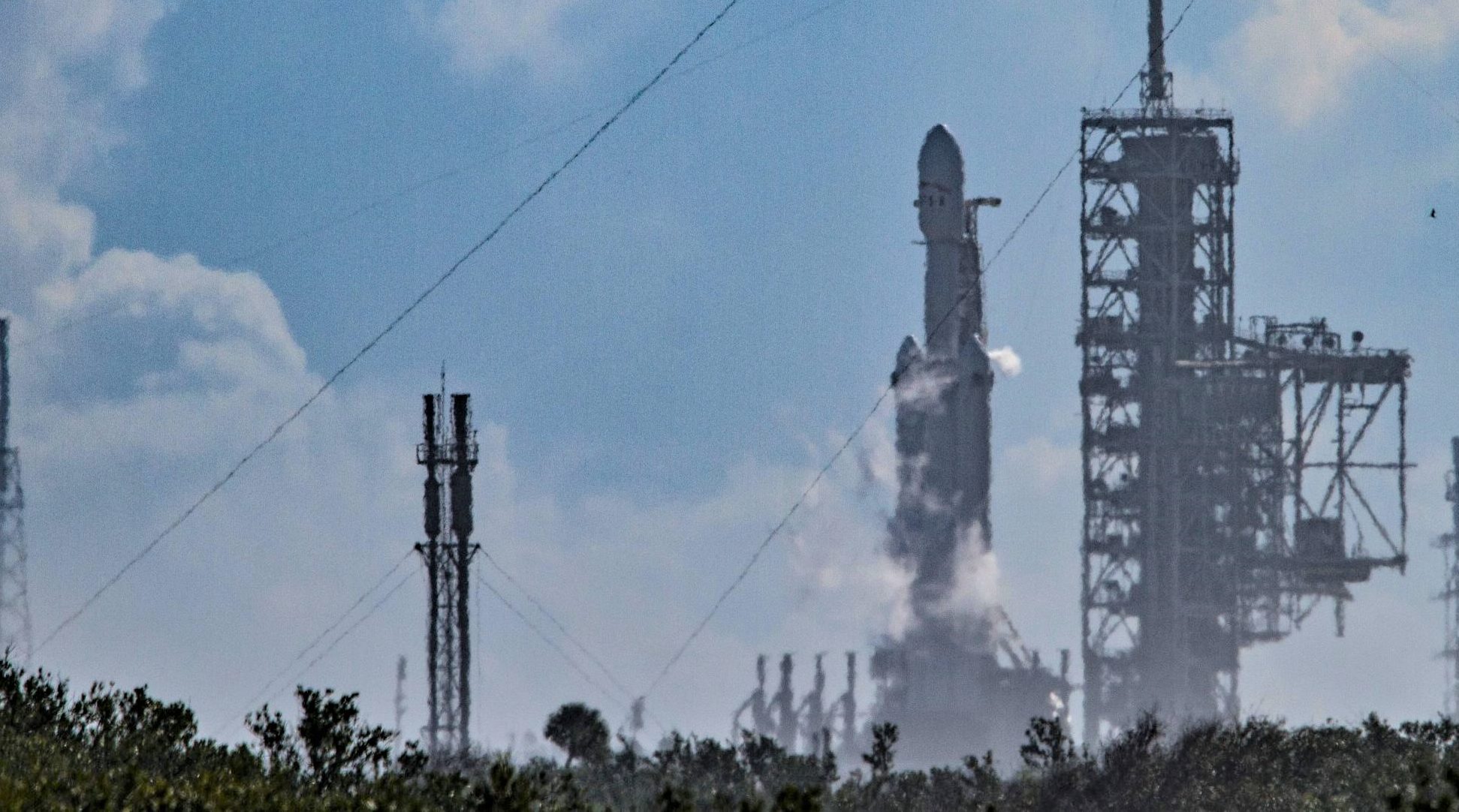
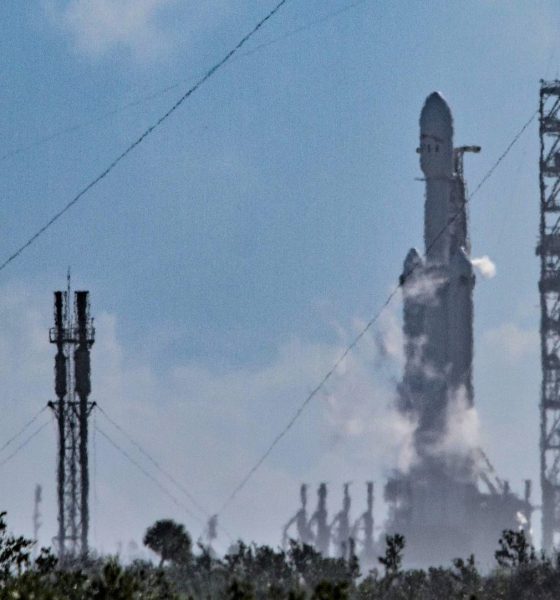
News
What’s causing SpaceX’s Falcon Heavy delays?
Although uncertainty in the schedule remains, SpaceX’s Falcon Heavy rocket appears to be nearly ready for its first engine ignition test (called a ‘static fire’) sometime within the next week or so.
An attempt at 1 PM EST today, January 16, was canceled for unspecified reasons, although Kennedy Space Center reportedly maintained the usual roadblock to prevent vehicles from driving past, implying that SpaceX still intends to conduct propellant loading tests with Falcon Heavy. It was noted earlier this morning by spaceflight journalist Chris Bergin that things were “a bit too quiet” if a test was indeed planned for today, and his intuition appears to have been correct. It still remains the case that Falcon Heavy is an experimental and untested rocket to an extent, and these delays are to be expected as SpaceX works out the inevitable kinks and bugs that arise during the extensive testing big launch vehicle has been and is still being put through.
KSC is in roadblock stance, so they will still do some testing it would seem, but we will have to wait for the Static Fire itself. https://t.co/DxzsRn85NR
— NSF – NASASpaceflight.com (@NASASpaceflight) January 16, 2018
Due to range requirements in support of an upcoming launch of the United Launch Alliance’s (ULA) Atlas 5 rocket, currently NET Thursday, SpaceX has postponed the static fire of Falcon Heavy without a replacement date. It is unlikely that another attempt will occur before the upcoming weekend, but SpaceX should have at least a solid week of uninterrupted range support once ULA’s launch occurs, hopefully without delay. Godspeed to ULA, in the meantime.
The crazy complexity of rocketry
Most recently, and perhaps somewhat related to Falcon Heavy’s static fire delays, SpaceX completed as many as two complete wet dress rehearsals (WDRs), which saw Falcon Heavy topped off with full tanks of its cryogenic (super cool) liquid oxygen (LOX) and rocket-grade jet fuel (RP-1). In essence, the rocket became equivalent to several hundred tons of carefully stabilized explosive. Nominally, these rehearsals appear entirely uneventful to an outside observer, with little more than ice formation and the occasional bursts of propellant tank vents to suggest that something important is occurring. However, anomalies like the failure of Falcon 9 during the Amos-6 static fire provide a staggering demonstration of just how explosive and sensitive a rocket’s fuel is, and Falcon Heavy has approximately three times the fuel capacity of Falcon 9. Empty, Falcon 9’s mass has been estimated to be around 30 metric tons, a minuscule amount of structure in the face of the more than 500 metric tons of propellant the vehicle carries at liftoff.
These propellant loading tests can also be challenging for reasons aside from their highly explosive nature. Due to basic realities of the physical nature of metal, the predominate ingredient for Falcon 9’s load-bearing structures, metallic structures shrink under extreme cold (and expand under heating). In the case of Falcon 9’s massive 45 meters (150 foot) tall first stage, the scale of this contraction can be on the order of several inches or more, particularly given SpaceX’s predilection towards cooling their propellant as much as possible to increase its energy density. For Falcon 9, these issues (thermodynamic loads) are less severe. However, add in three relatively different first stage boosters linked together with several extremely strong supports at both their tops and bottoms and that dynamic loading can become a fickle beast. The expansion or compression of materials due to temperature changes can create absolutely astounding amounts of pressure – if you’ve ever forgotten a glass bottled drink in the freezer and discovered it violently exploded at some future point, you’ll have experienced this yourself.
With several inches of freedom and the possibility that each Falcon Heavy booster might contract or expand slightly differently, these forces could understandably wreak havoc with the high precision necessary for the huge rocket to properly connect with the launch pad’s ground systems that transmit propellant, fluids, and telemetry back and forth. Information from two reliable Kennedy Space Center sources experienced with the reality of operating rockets, as well as NASASpaceflight.com, suggested that issues with dynamic loads (such as those created by thermal contraction/expansion) are a likely explanation for the delays, further evidenced by their observations that much of the pad crew’s attention appeared to be focused at the base of Transporter/Erector/Launcher (TEL). The TEL base hosts the clamps that hold the rocket down during static fires and launches, as well as the Tail Service Masts (TSMs) that connect with the Falcon 9/Heavy to transport propellant and data to the first stage(s). These connection points are both relatively tiny, mechanically sensitive, and absolutely critical for the successful operation of the rocket, and thus are a logical point of failure in the event of off-nominal or unpredicted levels of dynamic stresses.
- The white bars in this photo are half of Falcon Heavy’s seperation mechanism. A number of actuators take the place of the more common solid rocket motors used with vehicles like the Delta IV Heavy. (SpaceX)
- Falcon Heavy’s three boosters and 27 Merlin 1D engines on full display. (SpaceX)
- Falcon Heavy. Modeled and rendered by NASASpaceflight forum user WBY1984. (WBY1984)
Test, launch, land, repeat.
All things considered, these difficulties demonstrate that even after months (even years) of relentless modeling, testing, remodeling, and retesting, rockets (and especially huge rockets like Falcon Heavy) are immensely complex, and even tiny mistakes can lead the vehicle to stray from its expected behavior. Quite simply, the reality of engineering only truly comes into play once hardware is fully in the loop, and it’s in this state that SpaceX has demonstrated again and again a distinct and elegant ability to learn from their hardware, rather than attempt to salve uncertainty with a neurotic and counterproductive level of statistical analysis, modelling, and documentation. The agile launch company still dabbles in those aspects when beneficial or necessary, but testing comes first in its importance.
The conclusion here, then, is that Falcon Heavy’s delays betray this aspect of SpaceX – a launch company that loves its fans, but also understands the need for cautious testing when it comes to new and untried rocket hardware. Whether Falcon Heavy succeeds or fails, SpaceX will learn from the proceedings, and they will be better off for it (although maybe less so financially…).
Follow along live as launch photographer Tom Cross and I cover these exciting proceedings as close to live as possible.
Teslarati – Instagram – Twitter
Tom Cross – Instagram
Eric Ralph – Twitter

Elon Musk
Elon Musk and Tesla AI Director share insights after empty driver seat Robotaxi rides
The executives’ unoccupied tests hint at the rapid progress of Tesla’s unsupervised Robotaxi efforts.

Tesla CEO Elon Musk and AI Director Ashok Elluswamy celebrated Christmas Eve by sharing personal experiences with Robotaxi vehicles that had no safety monitor or occupant in the driver’s seat. Musk described the system’s “perfect driving” around Austin, while Elluswamy posted video from the back seat, calling it “an amazing experience.”
The executives’ unoccupied tests hint at the rapid progress of Tesla’s unsupervised Robotaxi efforts.
Elon and Ashok’s firsthand Robotaxi insights
Prior to Musk and the Tesla AI Director’s posts, sightings of unmanned Teslas navigating public roads were widely shared on social media. One such vehicle was spotted in Austin, Texas, which Elon Musk acknowleged by stating that “Testing is underway with no occupants in the car.”
Based on his Christmas Eve post, Musk seemed to have tested an unmanned Tesla himself. “A Tesla with no safety monitor in the car and me sitting in the passenger seat took me all around Austin on Sunday with perfect driving,” Musk wrote in his post.
Elluswamy responded with a 2-minute video showing himself in the rear of an unmanned Tesla. The video featured the vehicle’s empty front seats, as well as its smooth handling through real-world traffic. He captioned his video with the words, “It’s an amazing experience!”
Towards Unsupervised operations
During an xAI Hackathon earlier this month, Elon Musk mentioned that Tesla owed be removing Safety Monitors from its Robotaxis in Austin in just three weeks. “Unsupervised is pretty much solved at this point. So there will be Tesla Robotaxis operating in Austin with no one in them. Not even anyone in the passenger seat in about three weeks,” he said. Musk echoed similar estimates at the 2025 Annual Shareholder Meeting and the Q3 2025 earnings call.
Considering the insights that were posted Musk and Elluswamy, it does appear that Tesla is working hard towards operating its Robotaxis with no safety monitors. This is quite impressive considering that the service was launched just earlier this year.
Elon Musk
Starlink passes 9 million active customers just weeks after hitting 8 million
The milestone highlights the accelerating growth of Starlink, which has now been adding over 20,000 new users per day.

SpaceX’s Starlink satellite internet service has continued its rapid global expansion, surpassing 9 million active customers just weeks after crossing the 8 million mark.
The milestone highlights the accelerating growth of Starlink, which has now been adding over 20,000 new users per day.
9 million customers
In a post on X, SpaceX stated that Starlink now serves over 9 million active users across 155 countries, territories, and markets. The company reached 8 million customers in early November, meaning it added roughly 1 million subscribers in under seven weeks, or about 21,275 new users on average per day.
“Starlink is connecting more than 9M active customers with high-speed internet across 155 countries, territories, and many other markets,” Starlink wrote in a post on its official X account. SpaceX President Gwynne Shotwell also celebrated the milestone on X. “A huge thank you to all of our customers and congrats to the Starlink team for such an incredible product,” she wrote.
That growth rate reflects both rising demand for broadband in underserved regions and Starlink’s expanding satellite constellation, which now includes more than 9,000 low-Earth-orbit satellites designed to deliver high-speed, low-latency internet worldwide.
Starlink’s momentum
Starlink’s momentum has been building up. SpaceX reported 4.6 million Starlink customers in December 2024, followed by 7 million by August 2025, and 8 million customers in November. Independent data also suggests Starlink usage is rising sharply, with Cloudflare reporting that global web traffic from Starlink users more than doubled in 2025, as noted in an Insider report.
Starlink’s momentum is increasingly tied to SpaceX’s broader financial outlook. Elon Musk has said the satellite network is “by far” the company’s largest revenue driver, and reports suggest SpaceX may be positioning itself for an initial public offering as soon as next year, with valuations estimated as high as $1.5 trillion. Musk has also suggested in the past that Starlink could have its own IPO in the future.
News
NVIDIA Director of Robotics: Tesla FSD v14 is the first AI to pass the “Physical Turing Test”
After testing FSD v14, Fan stated that his experience with FSD felt magical at first, but it soon started to feel like a routine.

NVIDIA Director of Robotics Jim Fan has praised Tesla’s Full Self-Driving (Supervised) v14 as the first AI to pass what he described as a “Physical Turing Test.”
After testing FSD v14, Fan stated that his experience with FSD felt magical at first, but it soon started to feel like a routine. And just like smartphones today, removing it now would “actively hurt.”
Jim Fan’s hands-on FSD v14 impressions
Fan, a leading researcher in embodied AI who is currently solving Physical AI at NVIDIA and spearheading the company’s Project GR00T initiative, noted that he actually was late to the Tesla game. He was, however, one of the first to try out FSD v14.
“I was very late to own a Tesla but among the earliest to try out FSD v14. It’s perhaps the first time I experience an AI that passes the Physical Turing Test: after a long day at work, you press a button, lay back, and couldn’t tell if a neural net or a human drove you home,” Fan wrote in a post on X.
Fan added: “Despite knowing exactly how robot learning works, I still find it magical watching the steering wheel turn by itself. First it feels surreal, next it becomes routine. Then, like the smartphone, taking it away actively hurts. This is how humanity gets rewired and glued to god-like technologies.”
The Physical Turing Test
The original Turing Test was conceived by Alan Turing in 1950, and it was aimed at determining if a machine could exhibit behavior that is equivalent to or indistinguishable from a human. By focusing on text-based conversations, the original Turing Test set a high bar for natural language processing and machine learning.
This test has been passed by today’s large language models. However, the capability to converse in a humanlike manner is a completely different challenge from performing real-world problem-solving or physical interactions. Thus, Fan introduced the Physical Turing Test, which challenges AI systems to demonstrate intelligence through physical actions.
Based on Fan’s comments, Tesla has demonstrated these intelligent physical actions with FSD v14. Elon Musk agreed with the NVIDIA executive, stating in a post on X that with FSD v14, “you can sense the sentience maturing.” Musk also praised Tesla AI, calling it the best “real-world AI” today.
